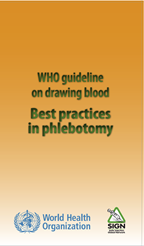
Injection safety
Making injections safe, we all have a part to play
All of us, at some point in our lives, will have an injection to retain or restore good health. But sometimes injections that are intended to promote health do the opposite. This happens when they are given in an unsafe way - using the same needle or syringe to give injections to more than one person. Practices like this can lead to the transmission of life-threatening infections. Patients and communities can play their part in safe injections by being aware of the risks of unsafe injections, the benefits of taking medicines by mouth and how to ask health care providers to consider alternatives to injections and where they are necessary, ensure that injections are delivered with a syringe and needle opened form new packets.
Guidelines
WHO has issued a number of evidence-based recommendations to support the implementation of safe injection practices. These policies, guidelines and best practice documents are available for download by a range of target audiences.
WHO has also published the WHO guideline on the use of safety-engineered syringes for intramuscular, intradermal and subcutaneous injections in health care settings, the first evidence-based policy document that specifically addresses the use of safety-engineered injection devices for therapeutic injections. It complements and expands previously issued WHO guidance. It is expected that the evidence-based policy guidance will additionally contribute to preventing the re-use of syringes on patients and to a decrease in the rate of needle-stick injuries in HCWs related to injection procedures, thus contributing to the prevention of infections transmitted due to unsafe injections.
Additional resources
Implementation resources
Job aids illustrating key steps for each of the blood drawing procedures were developed to make the phlebotomy guidelines more user friendly. These job aids are meant for end-users in order to have information readily available.
The cards and their holder can be printed, cut and folded to fit in a pocket.

Advocacy material for key stakeholders
- Advocacy leaflet for Ministry of Health
- Advocacy leaflet for Professional Associations
- Advocacy leaflet for Patient Associations
- Advocacy leaflet for Health-care providers
- Advocacy leaflet for Industry Members
- Advocacy leaflet for Media
- Advocacy leaflet for Donors
- Advocacy leaflet for Clinicians
- Advocacy leaflet for Civil Societies
Training tools
A range of educational tools exist for you to adopt and adapt to support health worker training on the safe and appropriate use of injections and related injuries.
IPC Training: Injection safety and needle-stick injury management
PPT | Trainer Guide | Student Handbook

In this OpenWHO course, you will learn about the causes of unsafe injection practices, how to safely give injections, and how to safely dispose of needles and other sharps. You will also learn what to do when needle-stick injuries occur, how to manage potential exposures, and ways to protect yourself, the staff and patients in your facility, and your community.
Monitoring tools












